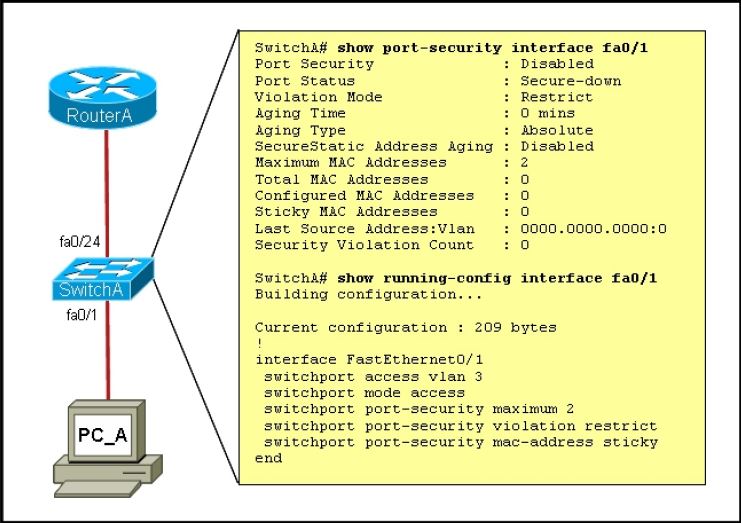
#Cisco mac address port mac#
After you have configured port security in the desired mode on a switch, it’s time to verify the configuration and the learned MAC addresses with the show port-security interface interface-id and with show port-security address. Switch(config-if)# switchport port-security violation restrict Switch(config-if)# switchport port-security mac-address sticky Switch(config)if)# switchport port-security maximum 10 If a violation occurs, you want the port to be configured in restrict mode.

Let’s now configure a sticky port security, to allow 10 MAC addresses on the interface. Recalling from above, the default behavior is to shutdown the port and allow only one MAC address. Switch(config-if)# switchport port-securityĪs you can see, we did not specify an action to be taken if a security violation occurs, neither how many MAC addresses are allowed on the port.

Switch(config-if)# switchport mode access Switch(config)# interface FastEthernet 0/1 Next, we will enable dynamic port security on a switch. If you enable switch port security, the default behavior is to allow only 1 MAC address, shutdown the port in case of security violation and sticky address learning is disabled. The default configuration of a Cisco switch has port security disabled. You can enable the port again with the no shutdown interface configuration command. Also, a SNMP trap is sent and the message is logged. In this mode, the switch ports shuts down when the violation occurs. shutdown – this is the default behavior on a switch.Specifically, a SNMP trap is sent, a syslog message is logged and the violation counter increments. restrict – is identical with protect mode, but notifies you when a security violation occurs.In this mode, you are not notified when a security violation occurs. protect – when the maximum number of secure MAC addresses has been reached, packets from devices with unknown source addresses are dropped until you remove the necessary number of secure MAC addresses from the table.A security violation occurs when the maximum number of MAC addresses has been reached and a new device, whose MAC address is not in the address table attempts to connect to the interface or when a learned MAC address on an interface is seen on another secure interface in the same VLAN.ĭepending on the action you want a switch to take when a security violation occurs, you can configure the behavior of a switch port to one of the following: In a Cisco switch, you are able to configuration three types of security violation modes. If you save the addresses in the configuration file, when a restarts or the interface shuts down, the switch does not need to relearn the addresses.When you disable port security, the sticky secure MAC addresses remain in the running configuration.When you disable the sticky learning, the learned addresses remain part of the MAC address table but are removed from the configuration.Are learned dynamically then converted to sticky secure MAC addresses and stored in the running configuration.Sticky secure MAC addresses have these characteristics:

Sticky secure MAC addresses – like Dynamic secure MAC addresses, MACs are learned dynamically but are saved in the running configuration.They are removed from the configuration when the switch restarts. Dynamic secure MAC addresses – are dynamically learned by the switch and stored in its MAC address table.These MAC addresses are stored in the address table and in the running configuration of the switch. Static secure MAC addresses – configured manually with switchport port-security mac-address mac-address.We will discuss theses security violation modes a little bit later. A switch can be configured to only protect or restrict that port. In most of today’s scenarios when the switch detects a security violation, the switch automatically shuts down that port. If the maximum number of secure MAC addresses has been reached, a security violation occurs when a devices with a different MAC addresses tries to attach to that port.
#Cisco mac address port full#
If you limit the number of allowed MAC addresses allowed on a port to only one MAC address, only one device will be able to connect to that port and will get the full bandwidth of the port. Any packet coming from other device is discarded by the switch as soon as it arrives on the switch port. When a MAC address, or a group of MAC addresses are configured to enable switch port security, the switch will forward packets only to the devices using those MAC addresses.

Switch port security limits the number of valid MAC addresses allowed on a port.


 0 kommentar(er)
0 kommentar(er)
